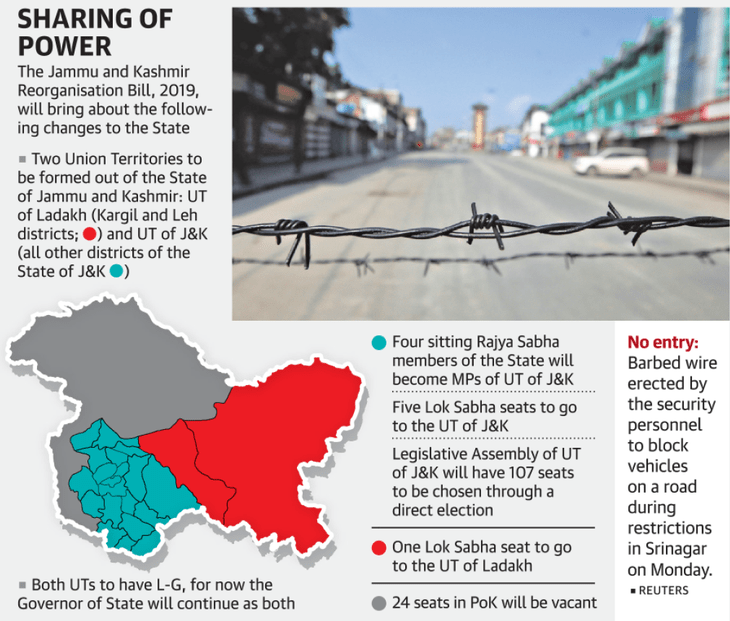Focus: GS-II Governance
Why in news?
- The new Union Territory of Jammu and Kashmir ( J&K) will be the only place in the country to undergo a delimitation exercise based on the population figures recorded in the 2011 census.
- Delimitation was last done in J&K in 1995.
- The latest readjustment of boundaries of constituencies in the States and other Union Territories has been done on the basis of the 2001 census and in future, it will be carried out based on the 2031 census.
Details
- The unique provision for J&K was enabled through an amendment introduced in the J&K Reorganisation Act, 2019.
- The Act passed by Parliament on August 6 bifurcated the State of J&K into the Union Territories of J&K (with a legislature) and Ladakh (without legislature).
- The J&K Assembly was dissolved in November 2018 and the region has been under Central rule since June 2018.
- Section 63 was introduced in the J&K Reorganisation Act so that the delimitation exercise can be conducted smoothly without overlapping with other provisions of the Delimitation Commission Act, 2002.
- The provision did not require any separate legislation as it was incorporated in the primary Act.
- The full Delimitation Commission is yet to be appointed.
- The delimitation will be done for 90 seats as 24 seats fall in Pakistan-occupied Kashmir (PoK).
- The exercise will take at least a year to complete. Till then, no Elections can be held
Jammu & Kashmir Reorganisation Act, 2019

- The Jammu and Kashmir Reorganisation Bill, 2019 was introduced in Rajya Sabha on August 5, 2019 by the Minister of Home Affairs, Mr. Amit Shah.
- The Bill provides for reorganisation of the state of Jammu and Kashmir into the Union Territory of Jammu and Kashmir and Union Territory of Ladakh.
- The Bill reorganises the state of Jammu and Kashmir into: (i) the Union Territory of Jammu and Kashmir with a legislature, and (ii) the Union Territory of Ladakh without a legislature.
- The Union Territory of Ladakh will comprise Kargil and Leh districts, and the Union Territory of Jammu and Kashmir will comprise the remaining territories of the existing state of Jammu and Kashmir.
- The Union Territory of Jammu and Kashmir will be administered by the President, through an administrator appointed by him known as the Lieutenant Governor.
- The Union Territory of Ladakh will be administered by the President, through a Lieutenant Governor appointed by him.
- The High Court of Jammu and Kashmir will be the common High Court for the Union Territories of Ladakh, and Jammu and Kashmir. Further, the Union Territory of Jammu and Kashmir will have an Advocate General to provide legal advice to the government of the Union Territory.
- The Legislative Council of the state of Jammu and Kashmir will be abolished. Upon dissolution, all Bills pending in the Council will lapse.
Delimitation Commission Act, 2002
- An Act to provide for the
readjustment of:
- The allocation of seats in the House of the People to the States
- The total number of seats in the Legislative Assembly of each State
- The division of each State and each Union territory having a Legislative Assembly into territorial constituencies for elections to the House of the People and Legislative Assemblies of the States and Union territories
- and for matters connected therewith.
- Delimitation literally means the act or process of fixing limits or boundaries of territorial constituencies in a country to represent changes in population.
Delimitation is done in order to:
- Provide equal representation to equal segments of a population.
- Fair division of geographical areas so that one political party doesn’t have an advantage over others in an election.
- Follow the principle of “One Vote One Value”.
The problems with delimitation are:
- States that take little interest in population control could end up with a greater number of seats in Parliament. The southern states that promoted family planning faced the possibility of having their seats reduced.
- In 2008, Delimitation was done based on the 2001 census, but the total number of seats in the Assemblies and Parliament decided as per the 1971 Census was not changed.
- The constitution has also capped the number of Lok Shaba & Rajya Sabha seats to a maximum of 550 & 250 respectively and increasing populations are being represented by a single representative.




